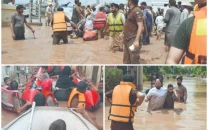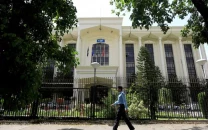Hakra River comes back to life
In the wake of Hakra River's rejuvenation, a village along its bank has witnessed a remarkable transformation.

“Fortunately, my land is on the bank of the Hakra River,” says 35-year-
old Ghulam Mohammad Chandio. “Taking advantage of this proximity,
and flood water from the river, I have cultivated my four hundred acres
of my land.”
Due to heavy rains and floods, the last three years, from 2020 to 2023,
have been very blessed and delightful for people in Chandio’s village of
Talhi Haji Jaffar Khan Chandio, about ten kilometers south of Nabisar
Road Town, near the right bank of the Hakra River.
Presently, what used to be their arduous lives have transformed into
joyous ones, while an economically struggling area has become
prosperous.
In these three years, Chandio has purchased three tractors for
cultivation and land preparation, apart from one vehicle for personal
use. “I have also constructed a new house in my village,” he says. “So
Hakro and flood are a blessing and bliss for us.
Perils of the past
Previously, from 1993 to 2020, his family struggled with finances. Even
with five hundred acres of agricultural land, managing daily expenses
was difficult, because their land lay wasted and uncultivated due to the
shortage of irrigation water. Since Chandio’s land is downstream of the
water irrigation system in Sanwari Shakh, the family witnessed some
hard times because they had no other source of income other than this
land which lay wasted. “We started selling our land bit by bit,” he said,
“and ended up selling a hundred acres just to be able to run the daily
expenses at home.”
But Chandio knew all along that selling off land was not the solution to
their financial woes. “If we continuously sell our land, in a few years, we
will have nothing left,” he realised.
He decided to leave the village to search for a job and found work as a
labourer in a textile mill in Karachi. “My salary was three thousand
rupees per month and certainly not enough for our family expenses,”
shares Chandio, who asked his younger brother, Mohammad Khan, to
leave the village and join him to work at the textile mill. They both
began to earn Rs 6000 and were able to afford to eat at least two meals
a day.
It seemed as though Chandio had created a pathway for young men
from his village to come to Karachi to work. “After my brother came to
Karachi, many other young fellows came one by one from our village
and started working with us and in other factories,” he says, adding
that by that time, many peasants in the village had ended up selling all
their land to meet the cost of living.
The surrounding area of the Hakro River, downstream of the water
irrigation system includes the southern districts of Umerkot,
Mirpurkhas, and Badin and near the Tharparkar desert in Sindh. This
uncultivated area which is approximately more than a hundred
kilometers from east to west begins from Chelbind, a little bus stop in
Umerkot district, to the Arabian Sea and Shakoor Lake.
Many families relocated to upper Sindh to find work as labourers, while
families who stayed behind began to cut wood for sale in nearby towns
such as Nabisar, Talhi, Naukot, and Bricks Bitha, which at the time was
the only source of income for the people in this area. “We only earned
two to three hundred rupees per day from wood cutting,” says Haji
Wasan. “In the jungle, many times we were attacked by bees.”
Drinking water was another issue at the time in the whole area and not
a one drop was available for birds, bees, animals, or people. People dug
wells and installed handpumps to meet drinking water needs of people
living in the area. This situation started after 1993 and 1992,” says 70-year-old peasant
Bhoro Bhel from village Nahtoo. “Previously, these lands were irrigated
with barrage water systems because, water-pumping machines were
not permitted in watercourses, therefore every farmer took his own
water from the water-irrigation channel.
“Water pumping machines were also used for stealing other people’s
water,” he adds. “Therefore, these machines made our area a
wasteland. Water-pumping machines are the main reason for the
shortage of water in this area. The irrigation water slowly became a
profitable business, with many shareholders including the local
feudals, elected members, Sindh Irrigation and Drainage
Authority, and the irrigation department being the prime
shareholders.”
The prosperous present
However, the floods have changed the entire situation in the area,
because Hakro is the main drain for flood water in Sindh, as it crosses
this area on its way to the Arabian Sea and Shakoor Lake.
The Hakro, an ancient river in Sindh, has not flowed for centuries and
the local inhabitants called it the dead river. Abdul Qadir Junejo the
renowned Sindhi and Urdu writer has written a novel "The Dead River”
based on the Hakro river.
In the colonial era, the Hakro River was used from Dhoronaro town
district, Umerkot, Sindh, to the Arabian Sea only in flood times for
discharging the flood and flash flood water. After the colonial period,
the river slowly converted into an abandoned marsh. Only a thin line of
its existence remained on the maps of Sindh.
But the flood of 2011 again brought the Hakra river to life as it started
flowing from the north behind the sand dunes of the Thar desert.
“After a long time, when Hakro began flowing in 2011, the peasants
were not prepared for cultivation,” says Imran Ali Dars, a 40-year-old
peasant from Nabisar, Thar city. “Hence, the peasants could not benefit
from the flood water in the river. After that, Hakro began to flow every
year for four to five months. Some peasants started cultivation using
flood water but in 2000, Hakro fluxed continuously for eight months.
This excited all the peasants enough to prepare their land and begin
cultivation.”
Gradually, the area transformed, with land prices increasing from Rs
40,000 to Rs 0.8 million, but the peasants did not want to sell their land
now at any rate. After years of being a wasteland, Hakro had made
their land precious.
Because of the flood water, the ground water level increased from 115
feet to 45 feet, and as a result, many farmers installed tubewells on
solar panels. Some fisherman families from Badin and Naukot arrived to
fish in the flood water.
“I was the first person who installed the first solar panel tubewell in the
area,” says Chandio. “People of my area would tell me that it would not
be a feasible idea. I ignored them and installed a tubewell which is
hugely successful. All women in the area take drinking water from
here, and men carry water on motorcycles and other vehicles.
One day of water from the solar panel tubewell is enough for one acre
of cultivated land. Following Chandio, other peasants also installed
solar tubewells in the area. “The water from tubewells is not excellent
for agriculture because the EC (Electrical conductivity) level is high,”
says Arshad Ali. “But it is acceptable for agriculture because it is better
than having no water.”
Talking about flood water being utilised for agriculture, Bhawani
Shanker, a senior scientist of soil and the divisional head of soil and
water testing laboratories at Mirpurkhas division, says "There is no hard
and fast theory about whether using flood water is beneficial or not for
land and crops, because it depends on the effusion of flood water.”
He explained that if water is drained from a salty or garbage area, then
it is bad for cultivation and drinking purposes, despite the fact that
generally rain water is considered beneficial for cultivation.
“Peasants must test water and soil before using flood water and ground
water for agriculture and drinking,” says Shankar. “After testing, we can
also suggest what type of crops can be cultivated in the area. Water
and soil testing charges are nominal, such as Rs 10 to 20 rupees per test
of soil or water.
Peasants could use flood water mixed with irrigation water to cultivate
salt-resistant crops, but the suggestions from the laboratory are based
on test results. In many countries, river water is also tested before use.
As livestock is rapidly increasing in the villages in the Tharparkar desert,
water from tubewells and the river is used for drinking and cooking. If
the growers test their land soil and water in laboratories, then could
enjoy more benefits from the flood water.
Where on one side, we heard horrific tales of damages caused by the
flood in upper Sindh, on the other hand, the flood water of the ancient
Hakra river has tremendously contributed to prosperity in the southern
district of Sindh and after a long time, the inhabitants of riverside
villages have returned to their homeland.
Khalid Kumbhar is a field researcher based in Mithi Tharparkar, Sindh. He tweets
@Jogekhalid
All facts and information are the sole responsibility of the writer



















COMMENTS
Comments are moderated and generally will be posted if they are on-topic and not abusive.
For more information, please see our Comments FAQ